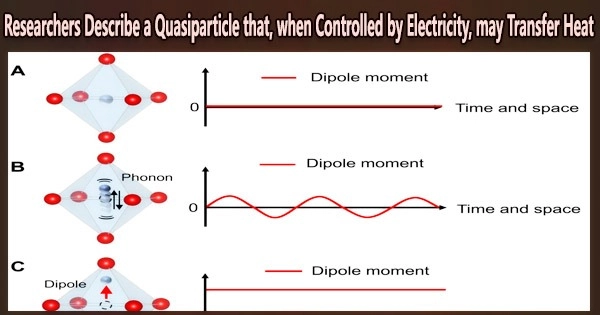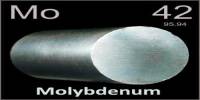By demonstrating that quasiparticles moving in wave-like patterns among vibrating atoms carry sufficient heat to transform the material into a thermal switch when an external electrical field is applied, scientists have discovered the mechanism underlying the ferroelectric property of solid materials.
A significant conclusion of the study is that the material’s structure, rather than atoms colliding at random, controls thermal conductivity.
The ability of the material to transmit heat at various rates is determined by the ordered wiggling and polarization of quasiparticles termed ferrons, which “wiggle” in between vibrating atoms. This polarization is responsive to the externally supplied electrical field.
“We figured out that this change in position of these atoms, and the change of the nature of the vibrations, must carry heat, and therefore the external field which changes this vibration must affect the thermal conductivity,” said senior author Joseph Heremans, professor of mechanical and aerospace engineering, materials science and engineering, and physics at The Ohio State University.
“People tend to think atom vibrations are a given fact and don’t respond to an electric field or a magnetic field. And we are saying you can affect them with an electric field.”
The ability to control this type of material’s thermal conductivity at room temperature rather than at the extremely low temperatures required to control most candidate materials for solid-state heat switches expands the potential for practical applications of the technology, according to the researchers.
The ferron is also sensitive to strain in the solid. Since the ferron carries heat, that makes the amount of heat carried dependent on the electrical field. So we wrote a new theory that relates an external electric field, the strain it induces in a ferroelectric, and ultimately how this strain affects the thermal conductivity.
Professor Joseph Heremans
The study is published today (Feb. 1, 2023) in the journal Science Advances.
The material utilized in the study is a typical lead zirconium titanate ceramic, which is a type of piezoelectric material that may change form in response to an electric field or generate an electrical charge in response to mechanical stress.
Ferroelectrics, a subset of piezoelectrics, are materials in which the electrical charges on the atoms can spontaneously form electrical dipoles that all align in the same direction, forming what is known as polarization. These dipoles can be switched by an external electric field.
It has not yet been explicitly documented by scientists how this polarization would change when heat is introduced. The ferron, a quasiparticle that simultaneously carries heat and polarization waves, is used to describe this motion in the new article. The ferron is sensitive to an external electric field, and that means the application of an external electrical field can turn the material into a heat switch.
“The quasiparticle has always been there. It just hasn’t been identified and measured,” said first author Brandi Wooten, a Ph.D. student in materials science and engineering at Ohio State.
Wooten likened ferrons’ behavior to a stadium wave, with each sports fan representing a cell of atoms collected together in a crystal.
“You have all these atoms, and they have this special dipole an atom with an electrical charge that moves up and down creates a dipole. You can think of people’s hands going up doing the wave as the dipole’s strength if their hands are up, it’s really strong. If they’re a little bit down, it’s weaker, and if they’re all the way down, it’s negative,” she said. “That’s the dipole’s strength. We found that these special waves carry both heat and polarization, and we labeled them ferrons.”
This heat-transferring property is induced by the electric field through a phenomenon known as the piezoelectric strain: When a voltage is given, the lattice shrinks or extends as a result of the movement of the atoms and forces inside it. This alters the material’s mechanical characteristics and, as a result, its thermal conductivity, said Heremans, also an Ohio Eminent Scholar in Nanotechnology.
“The ferron is also sensitive to strain in the solid. Since the ferron carries heat, that makes the amount of heat carried dependent on the electrical field,” he said. “So we wrote a new theory that relates an external electric field, the strain it induces in a ferroelectric, and ultimately how this strain affects the thermal conductivity.”
Since the theory is predictive, scientists can now use it to identify materials in which the effect is significantly greater, eventually leading to materials in which it is significant enough to be used in heat switches in commonplace applications, such as solar power gathering.
The new hypothesis predicted that there would be a 2% variation between the material’s maximum and minimum conductivity when an electrical field was applied to it.
A series of experiments quantifying the atomic vibrations through measuring the velocity of the material’s sound waves and equilibrium and transport properties validated “that this all depends only on the material structure, not necessarily what’s scattering the vibrations,” Wooten said.
As predicted by the new theory, the researchers are already looking at other materials that could enhance that change in thermal conductivity by up to 15%.
“Any application depends on us finding a material where the effect is much larger,” Heremans said. “We are looking for materials that have the right parameters.”
Additional co-authors include Ryo Iguchi and Ken-ichi Uchida of the National Institute for Materials Science in Japan; Ping Tang and Gerrit Bauer of Tohoku University; and Joon Sang Kang of Ohio State.
















